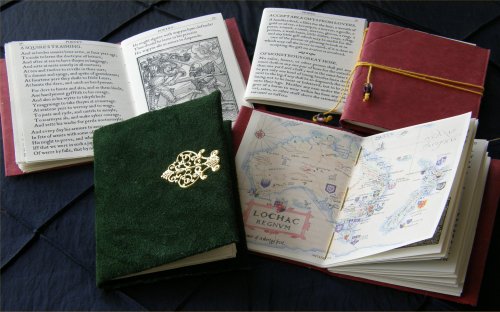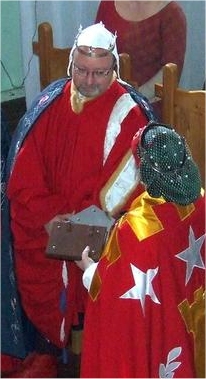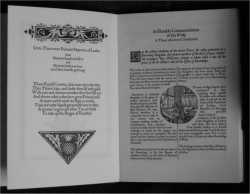 |
|
Commonplace Books...or period scrapbooking for the SCA
Royal Commonplace Book
A commonplace book is what a provident poet cannot subsist without, for this proverbial reason, that "great wits have short memories;" and whereas, on the other hand, poets, being liars by profession, ought to have god memories; to reconcile these, a book of this sort is in the nature of a supplemented memory, or a record of what occurs remarkable in every day's reading or conversation. There you enter not only your own original thoughts (which, a hundred to one, are few and insignificant), but such of other men's as you think properly fit to make your own, by entering them there. For, take this for a rule, when an author is in your books, you have the same demand upon him for his wit as a merchant has for your money when you are in his. Historical BackgroundCommonplace books were compendiums of knowledge, typically filled with notes on a huge variety of topics: quotes, poems, recipes, lists, laws, prayers, proverbs, jokes, heraldic blazons, predictions, mathematical tables, astronomical/astrological lore and so on, representing whatever interests the writer had. Think of the modern penchant for scrapbooking or blogging. During the earlier part of the Renaissance, they were handwritten journals, often used by students for compiling notes, by legal folk for tracking laws and judgements, or by scholars keen to take note of especially relevant bon mots. The term "commonplace" implies passages collected under common headings with the intention of remembering or referring to them. The term was first used to refer to such collections in 1578 (Oxford Dictionary), although the practice was known to the Greeks of the 5th century BC. The common theme quickly broadened and commonplace books came to be filled with all manner of information. This followed on from popular collections of broad-based knowledge, such as Caxton's Polychronicon printed in 1477 based on a variety of collected material and, later, segued out into the popular Tottel's Miscelleny of songs and sonnets and other material. Commonplacing really took off in England from the 1400s, aided by the provision of cheap paper and a growing interest in scholarship. By the time of Tudor England, commonplace books had become a part of everyday life: Boys ... had to keep notebooks or commonplace books in which to record, and then learn, idioms, quotations, or figures useful in composition or declamation. Not a little of that wide learning and impressive range of quotation adorning Elizabethan literature comes from these commonplace books. The British Library collection of 50 or so such books dating from 1550 to 1700 includes the "Waferer" versions which has verses by Essex, Ralegh and Shakespeare, as well as medical recipes, lists of books, and notes; and one attributed to Thomas Harriot which contains the earliest known quotation from Shakespeare's Henry IV Part 1. When used in an organised fashion, commonplace books could be structured to encourage the user to cover a set course of study, or to arrange their collection of excerpts in an orderly fashion to support a particular discipline. Erasmus and other humanist scholars were at the forefront of promoting this approach. On occasion, commonplace books were divided into appropriately contemplatory topics such as virtues and vices (Moss, v). With the development of the printing industry, such books were produced with a selection of pre-printed headings and decorative borders as blank journals; John Foxe, best known for his Book of Martyrs, printed a popular version. However, the British Library collection shows that some users ran of out steam and left much of their preprinted pages blank. For less-driven folk "who did not have the patience or the resources to gather their own entries" there was the option of buying a version with suitably worthy quotations already printed or written in (Sherman). As commonplace books became more common, so did their usage, with books broadening out to compilations of non-scholarly information such as business accounts, correspondence archives, diaries, catalogues of possessions, travel itineraries and sketches. The British Library collection shows commonplace books passing through a number of owners, each with different interests demonstrated by their inclusions: It is not at all unusual to find a collection of legal records or historical notes written around an earlier compilation of philosophy or poetry, written sideways or upside-down in any available space. It should be noted that combinations of written and printed material in a single volume were, well, commonplace. One particularly extensive example is the 1,200-page, 60-year production of Sir Julius Caesar (1558-1636), held by the British Library. His book began as one of Foxe's blank commonplace texts (Pandecte Locorum Communium, printed in 1572), which included "a printed title-page, address to the reader, subject headings, and alphabetical index, with the pages below the headings left blank for the reader to fill in". Caesar also added his own headings and an index, along with a vast compilation of notes, lists and other material that piqued his interest over the decades. Other authors, such as the Venetian Bernard Bembo (1433-1519) used alphabetical tabs, marginal notes and even "elaborate pointing fingers" to navigate around the stuffed journals (Sherman). The books themselves varied considerably, with many having different sized pages as a result of insertions or rebinding. Examples of sizes include 312 x 200mm and 207 x 140mm. The pages were usually of paper, with vellum commonly used as a cover, tied with silk ties. At least one of the British Library examples shows the book in a leather wallet binding, closed with a strap and buckle.
My Commonplace BookBearing in mind the examples of this type of production, I decided to produce a commonplace book that would provide period instructional material, useful information for the SCAdian, and blank spaces for the user to add their own material under a variety of suitable headings (eg addresses, poetry, recipes, songs etc). The examples I have seen of printed commonplace books indicate a mix of type, with a strong reliance on blackletter. In deference to making the material readable, i have chosen to use Jeff Lees' fonts, which offer a close-to-period style. As is my standard practice for bulk printed works, I haven't used the ligatures or letter replacements. At 75 x 100mm, the size is significantly smaller than most of the commonplace books extant, but this was deliberately chosen as I wanted this book to be readily transportable in a pouch to provide greatest utility. It is comparable in size to the penny chapbook. The pages were laid out to produce 16 pages per A4 sheet, with a total of 64 pages based on two double-sided A4 sheets per signature. Rather than folding and then cutting as was usual practice, I decided to try making the basic folds and cut the pages as I went. This was mainly because the size of the pages and nature of the laid paper made folding crisply difficult. The pages were typeset to allow two colour plate prints (16 pages out of 64). I did toy with the idea of hand-washing the colour, but decided against that in the interests of time and efficiency. As it is, I did experiment with a form of over-printing by inserting the colour blocks in the Arms page to see what sort of effect that provided and came to the conclusion that it wasn't really suitable for what I had in mind for this project. The bulk of the books I have made have a book vinyl cover comparable to limp vellum, used primarily for economic reasons and as a reasonable approximation of a period style. A few presentation copies have been covered in a handsewn leather slip, with the addition of clasps or other suitable book furnishings. I'm still tracking full provenance for the sewing method, but Master Crispin Sexi has described seeing examples of this through-the-spine approach cited in The Archeology of Medieval Bookbinding by J. A. Szirmai. It may be some time before I get to see that -- copies on Amazon start at US$200.... In a New York Review article, Robert Darnton opined that commonplacing had "disappeared long before the advent of the sound bite". Clearly I must be a throw-back as, between the ages of 8 and 18, I had written a commonplace book without ever realising its historical precedents….or perhaps it would be better to quote Sherman's view when he referred to the "variety, brilliance, and quirkiness of the intellectual habits [these books] document". One of the delights I had in sourcing material for the book was gaining permission from Duke Siegfried von Hoflichskeit to use his poem covering the Rules of the List. I hadn't realised that the good Duke was one of the fighters in the First Tourney...
PDF Version
Commonplace Book (PDF, 7MB)
ContentExamples of topics from the British Library collection of commonplace books: The following list provides some notes for the sources of the material used in my commonplace book. Particular thanks must go to Duke Siegfried von Hoflichskeit, Baron Giles Leabrook and Finnr of St Kessog for their generosity in allowing me to abridge their longer works to permit inclusion, and I urge you to seek out the original material. Introduction. The title page used woodcut borders with a printers' mark (my kk sigil), and an ex libris box -- with a batch of these books liely to be around it needed a means for the owner to identify their book. The salutation to the reader followed period style, with an apt quote from Erasmus: As they flit like so many little bees between Greek and Latin authors of every species, here noting down something to imitate, here culling some notable saying to put into practice in their behavior, there getting by heart some witty anecdote to relate among their friends, you would swear you were watching the Muses at graceful play in the lovely pastures of Mount Helicon, gathering flowers and marjoram to make well-woven garlands. Addresses. The book included a page on how to address the nobility, noting the various titles used in the SCA, then blank pages for the user to add adderss information of a more mundane nature. Advyse. I collected various bon mots ranging from how to be a good husband and a good wide, courtesy of the Mediaeval Lore of Bartholomew Anglicus to admonitions from Erasmus and da Vinci regarding suitable behaviour. Armour and Arms. This consisted of a labelled set of armour, with the standard naming of parts (pace Wilfred Owen). A blank shield allowed the owner to draw in their own arms, with a space beneath for blazoning; this was a common iamge seen in numerous period commonplace books. Bestiary. This section covered a number of creatuers of interest, including the comment of Physiologus on the Pelican, Anglicus on the Whale, Pliny on the Bonasus and the Elephant, and Isidore of Seville on the Mandrake and Hedgehog. Cartography. I made use of the centrespread of the first quire to insert a colour plate of the Kingdom map of Lochac. This was originally worked by Benedict Stonhewr of Askerigg, with an online version updated regularly by Ronan mac Brian. Daies of the Year. This calendar section mentions a number of the large annual events occurring throughout the Kingdom of Lochac, such as Canterbury Faire, Festival, Cold War, Brass Monkey War and so on. I thought this would be handy, specially for international travellers as it can sometimes be difficult to remember what is on when. Each month also has a short item of related text or an image to go with it. Thus April includes a quote from Shakespeare about St George to mark St George's Day (April 23); June includes a line from the Magna Carta, signed that month; November has a comment about the life of St Katherine, whose feast day is celebrated then. Medical Lore. This has a quote on madness from Bartholomew Anglicus, a couple of handy recipes for good health and a nice quote from a 1439 petition from the Commons to the King regarding how they wanted to forego any fealty kiss for fear of spreading the plague; that came from the Anthology of Chancery English Mores. Some more fun snippets on various topics, such as what to do with a clov'd lemon; what Andreas Capellanus tells us in The Art of Courtly Love regarding which gifts are acceptable from a lover; a Statute of Apparel from 1562 on Monstrous Great Hose; the Characters of Nations which, although in Latin, is readily understandable and probably still considered apt in terms of national stereotypes (eg varietas Affrorum; gravitas Romanorum; ferocitas Francorum; vinolentia Hispaniarum; magnanimitas Pictorum; hospitalitas Britonum). Lord Montague's Book of Rules and Orders of 1595 provided an interesting list of Steward's Duties. Poetry. I left a number of pages blank in the Poetry section so that people could fill in their favourites, but included a couple, such as Shakespeare's 14th Sonnet (When in disgrace) as one of his most accessible, and the treatise on A Squire's Training. Prayers. Regardless of one's attitude to religion, it would be appropriate for most of us to know the Ave Maria and Pater Noster. Prognostacaycons. I had used these in my chapbooks, taking extracts from A Wonderfull Astrologicall Prognostication, in ridicule of the almanac-makers, allegedly penned by Adam Fouleweather, commonly attributed to Thomas Nashe; and some from Chapter 25 of the Third Book of Pantagruel by Rabelais. They were illustrated with a wood engraving from Camille Flammarion's L'atmosphère: météorologie populaire; this 1888 engraving is often misattributed to 16th-century German due to similar images in Munster's Cosmographia of 1544, but it still makes a great statement regarding the place of man in the medieval mindset. Prose. Like the poetry section, this contained blank pages, along with various quotes, and proverbs from the Compendium of Common Knowledge. Recipes. I put three favourite recipes in here. The Icelandic Chicken was one I originally had from Maddog Mattson, sent to me in response to a request for pigeon recipes; I adapted it and won a cookbook in a cooking competition in Japan using it! Cariadoc of the Bow has a version in his Miscellany. The recipes for Ypocras and Senkanjabin also have many variants in use. Riddles. Two of the riddles are from The Ænigmata by Symphosius; one of the suggestive ones from the Exeter Book of Riddles, and one classical conundrum said to have led to Homer's death by frustrated riddle-solvers. No, I'm not going to give away the answers here, in case that's what you're after. Excerpts. I was fortunate to gain permission from three kind gentlemen to take extracts from their longer works. The Beneath Southrern Skies drapa of Finnr of St Kessog was written to celebrate the baronies of the Kingdom of Lochac. At Canterbury Faire, he was awarded a Prix Jongleur by King Alfar who challenged Finnr to "do something". Without batting an eyelid Finnr launched into the drapa, reciting all of it from memory much to the wonder and joy of the populace. It's a very clever piece with a lot of subtle references to each of the Baronies and their leaders within it. The Lochac Saga was penned by Giles Leabrook, and is kept updated as the heads under the Crowns change. The poetical Rules of the List was written by Duke Siegfried von Hoflichskeit for the Kingdom of the West's Fall Coronet in ASXX. I came across it on the Shambles during a discussion of ways of memorising the rules, and was very pleased to be able to both find the Duke and gain his permission to abridge the material and adapt it slightly. Song and Dance. I included a number of common songs where the lyrics have always seemed to elude me -- Alle Psallite, Coventry Carol and Pastime with Good Company -- and I had to include Crispin Sexi's anthem for Southron Gaard, along with the bass burdern's line in Jeff Lee's period musica font. There are blank pages for others to be added. I also included abbreviated instructions for some of the common dances, including a number from the Southron Gaard Set: Single Bransle, Horses Bransle, Official Bransle, Lorayne Alman, Earl of Essex Alman, Heart's Ease and the Known World Pavane. All but the latter are near-period. A couple of blank unlabelled pages finished off the book, and the colophon on the final page expressed my thanks to all those who had helped with work, suggestions, corrections and suchlike. Thanks again! Royal Commonplace BookUnder prodding from Lady Sancha da Sylva, who was keen to bind something, I produced a variant of the commonplace book as a gift for the Lochac Crown, and adapted it later as a gift for incoming B&B cousins, as well as for Christopher and Clare who followed us as Baron and Baroness of Southron Gaard..
I designed the book to be produced in a set of separate signatures of 32 A5 pages apiece, printed quarto. This was a suitable size for Sancha to bind and meant that I could readily layout the separate sections as information and Muse permitted. The sections were as follows: IntroductionThis was a 12-page sig with a set of blank pages at the front to provide endpapers. It included a title page personalised for the recipients, a period-style dedication, and advice for Royals and their representatives courtesy of Machiavelli, Castiglione and Christine de Pisan. I adapted sections of the dedication from Castiglione, such as: Those Royall Crowns, that reare up to the skye Kingdom CalendarContaining a Yearly Planner with Important Dates Mark'd & also Much Diverting and Useful Comments to Educate the Mind and while away Time if such be Available.This contained a quick planner for the year, based on a standard Collins diary, with sections to note Crown Events and useful reminders (such as renewal of membership dates!). It then went into a double-page spread for each month with blank space for writing in notes and a scholar's column filled with words of advice, mostly relating to the time of year, saints, the dates of the main regional events and Crown events around the Kingdom, etc
Calendar Signature (PDF)
CourtIncluding Useful Lists to Aid and Assist the Smooth Operation of Court. & Also The Royal Line of Lochac.Pages for listing members of the Court and their roles, a list of previous Crowns, pages for gifts given/received, tips for suitable gifts, advisable things to have in a Royal basket, awards given. This has since been incorporated into the Intro section. On request from one Crown, I've also included the standard fealty oaths for peers and territorial Barons and Baronesses. KingdomShewing its Divers Baronies, Cantons, Shires and Colleges that spread from the far West to the East, from the heat of the Northern climes to the icy realm of the Great White Southern Lands. And Including a List of Officers and such Nobles as serve the Kingdom and the Populace in Divers manners.The included the full Kingdom regnum with space for updating it, including SCAA/SCANZ committee and contacts, all the groups with contact details and all their heraldry hand-drawn by Benedict Askerigg, Herald Astrolabe, (though printed on an ink-jet), and blank pages for other contact information. Laws and CeremoniesLochac Award Ceremonies Including Images of Award Tokens where extant to aid the identification Thereof & The Laws of Lochac concerning all Manner of Important Aspects necessary for the Legal Operation of the KingdomThe ceremonies section stated with the Fealty Oath, then went through all the main awards ceremonies (other than Peerages and Baronial change-overs). It include hand-drawn pictures of the award tokens (it's easy to forget what awards there are and which token goes with what, specially as the names of some have changed recently!). The Kingdom Laws always seem in the process of being revised, but I also included a link to the online site where the new material was to be posted. The Gentry ListOne Crown asked me if it would be possible to have a list of the populace and their awards. I gulped and replied "Of course, Your Majesty"... The very helpful support crew for Lochac's Canon Lore, ably led by the ever-thoughtful Baroness Teffania Tuckerton, rejigged the database to help produce a very handy printout of the Kingdom's Gentry List -- all the people in the Kingdom who had been given awards, their SCA and mundane names, group and awards. I went through and reduced as much of it as possible to abbreviations, then put the 2000+ list into 8 point font and managed to fit it all within the standard 32-page quire. Perhaps I should add a magnifying glass to a built-in bookmark! Production
I printed out the material once typset and sent it off to Sancha. We had a helluva time with the first attempt through various mishaps with post and courier firms, but the versions did make it to July Coronation to be presented to Their Majesties Siridean and Sibhan. A second variant was made for the Investiture of the new Excellencies of Ildhafn. Sancha bound these too and I finally got to see them at Invest - they looked great. Since then, we have been producing them for each new Crown. Our latest idea was to print them in advance of Crown Tourney so that they could be presented to the Prince and Princess straight after Crown Tourney to help Them hit the ground running -- the information the books hold is valuable for anyone preparing to become Crown. This meant that we had to leave a space at the front for the names to be written in, and Master Iarnulfr plied his quill beautifully (as always) to enter the names of Gabriel and Constanzia as the winners of May Crown in Darton AS XLIV. For more pictures of Sancha's binding, see here. Lady Isabel Winter has also kindly undertaken binding of the Royal Journals, with the two generous ladies sharing the load by alternating; you can see some of her work here.
In AS44, His Majesty Bran asked if I would produce a version for the new Prince and Princesse of Insulae Draconis, as a gift from the Kingdom of Lochac -- the inaugural Coronet Tourney was being held in Thamesreach (London), jocularly (and fairly accurately) known as Little Lochac on Thames. It was a tricky assignment as getting the necessary information on laws and awards proved difficult, but I managed a slightly smaller version with material of relevance to Insulae Draconis (the UK, Ireland and Iceland). This version was bound at Canterbury Faire by Lady Isabell Winter. My lord and I happened to be arriving in Thamesreach the morning of the tournament, so I was able to present the gift at the Court. I charged any locals interested in period printing or binding to continue the tradition to support their royalty, and I gather that this challenge has been taken up -- huzzah!
| ||||||||||||||||||||||||||||||||||||||||||||||||||||||



